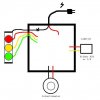haha, well... You gotta start somewhere. We have another guy on here that uses paint to draw things

You will most likely want to use more than one potentiometer.
A Master that is externally available to adjust as a 'master' volume, and smaller potentiometers inside the magic box that will allow you to adjust sensitivity per channel, and alight adjustment to the frequency you want passed through.
I'd like to help you learn, so before I give you the diagram, im going to tell you to do a little google search for "RC Highpass", "RC Bandpass", and "RC Lowpass" these are very very simple circuits requiring only a small number of capacitors and resistors (4 of each to build all 3)
Your input will go to your Master Potentiometer to adjust overall sensitivity, then will branch off to each of the 3 types of filters. Each filter will go to its own comparator which we can look at shortly.
*How do you plan to connect this?
Using the 'Line-out' of an audio device is different from using a headphone jack. This is due to a different impedance from the source. It would help to know to help ensure we don't inadvertently alter the sounds too much.
Do you plan to put in a built in speaker?
You should probably add a second RCA or 1/8" connector as a passthrough so that you don't have to worry about messing with Y-cables.

Edit: More homework.
Figure what frequency you want to consider 'Bass' and 'Treble' and what range you want as 'mid'
There are a set of loose standards. You can play with Audacity or other audio editing software to listen to a song after you send it through a 'low-pass' to see what it sounds like. By playing with the numbers like this. You can determine what would work well for your particular tastes... (ie. red light on drums, or only for the really low notes from Dubstep)
Remember that this circuit works based on how large the signal is... it will not be able to pick out certain instruments if there is another sound in the same frequency group that is louder.

